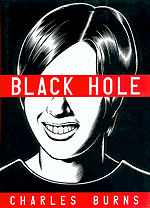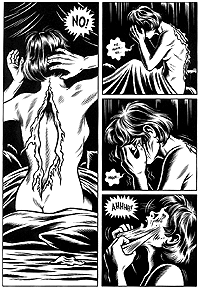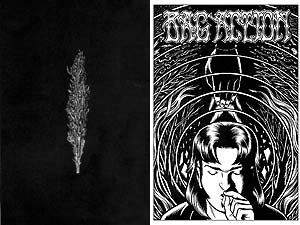
|
Set in the suburbs of Washington State during the mid-1970s, Black Hole evokes that era's great teenage exploitation movies with its attention to atmospheric detail. It even begins in typical teen horror gross-out fashion, with the two protagonists in biology class, hunched over the slit belly of a supine frog. Shaggy-haired Keith digs the fact that he has been partnered with the "total fox" Chris Rhodes. But as he stares into the spilled amphibian guts he becomes overwhelmed by a dark premonition: "I felt like I was looking into the futureand the future looked pretty messed up." Overwhelmed, Keith passes out on the floor as a swirl of images, including a foot with a gash and a hand covering a pubis, swirl before him, setting the tone of intense sexual danger that hangs over the book.
The principal conceit of Black Hole is that a disease called "the bug" has been infecting teenagers who engage in sexual activity. But instead of causing pain or sores or even death, the infection results in freakish deformities of varying degrees. One character develops a small tail, another a second mouth at the base of his neck, and others sprout tumescent growths on the face or webbing between their digits. They seem like corporeal manifestations of their inner souls. (If you were going to develop a strange growth, what would it look like?) Every sensitive outcast's nightmare comes true as those infected become as outwardly repulsive and rejectable as they feel inside. Some simply remove themselves entirely from society, preferring to live in the woods under garbage bag tents, eating pilfered junk food.
 Chris sloughs off in 'Black Hole'
Chris sloughs off in 'Black Hole' |
Black Hole has as much fun defying the teen horror conventions as working within them. Keith and Chris do not fall in love, as you might expect, while battling hordes of monsters. In fact, the first two thirds of the book follows each in parallel but separate stories. A stoned philosopher, Keith goes through his days working hard at doing nothing and just getting a good buzz on. After stumbling upon a colony of infected teens near his favorite woodsy spot for getting stoned, he starts to become aware of their isolated but darkly appealing world. While everyone else spends their time getting doped up on drugs or TV, the "bug" kids come off as genuinely friendly and inclusive. Soon Keith lets himself be seduced by an infected young woman named Eliza, apparently embracing the bug as just one more "trip."
Chris, meanwhile, deals with the consequences of inadvertent infection. She hooks up with Rob, a cute guy who, as she discovers in the act of coitus, has a second mouth that utters his deepest thoughts. "It's impossiblennnnever make it out alive." While enduring the usual high school dramas — a pregnancy scare as he avoids her in the hallways — things get worse when she discovers she can shed her entire epidermis like a snake. So, outed at the school, she flees to the woods with Rob, who has disclosed his true feelings for her. Almost literally ensconced in a love nest, things go really bad when Rob vanishes and a dismembered arm appears.
 A chapter diptych featuring Keith
A chapter diptych featuring Keith |
Though Burns has been making comix since the early 80s, Black Hole is his first full-length graphic novel. Given that it took ten years for this book to reach completion, it may also be his only one. (It appeared over time as series of twelve comic books.) But you can't fault Burns for laziness. Once you see one of his illustrations, you see why it took so long. Possessing a graphical style as unique and instantly recognizable as Edward Gorey's, Burns works in meticulous detail using heavy inks that seem to bring out the worst horrors of anyone or anything. He will individually trace each hideous hair of an emerging mustache above an adolescent lip, for example. Some of the most intensely high contrast comix every created, everything is made up of either pure white or jet black, and mostly the latter. Visually, it's one of the most stunning graphic novels yet published. Incredibly, although it took a decade to finish, the style stays completely consistent from page one to page 368.
Part of that consistency is in the careful follow-through of visual motifs introduced in the earliest chapters. Black Hole may be the most Freudian graphic novel you will every read. Dreams and symbols play a major role the development of character and theme. Vaginal-like openings appear in such forms as branches being pushed aside or a cut on someone's foot. Guns and serpents make for opposing sexual symbolism. While such imagery has been used before, Burns smartly applies them in ways unique to the medium, integrating them into the very design of the book.
For example, each chapter begins with a two-page diptych. The left page features a still life, usually of a small, discardable piece of detritus, set against a black background. The right page typically shows a character arranged in the same geometry as the left. A half-eaten hamburger viewed from above on the left echoes Chris curled up in the fetal position on the right. Once you notice this you soon discover that, even though the layouts remain constantly varied, nearly every page vaguely or explicitly reflects the construction of the page facing opposite. Imagining the amount effort put into this books visuals makes you wonder why it didn't take twenty years to finish. Black Hole is a tour de force of design as message. Semiotics students will pore over it for years to come, but casual readers will simply enjoy it for its dark beauty.
In Black Hole Charles burns has taken the tropes of the teenage horror genre and powerfully brought them back to their roots. Fear of adulthood, fear of sex and fear of ostracization have never been more disturbingly explored in a serio-comic flashback to bellbottoms, big doobies and skinny-dipping in the woods. No Black Hole was ever so scary.
